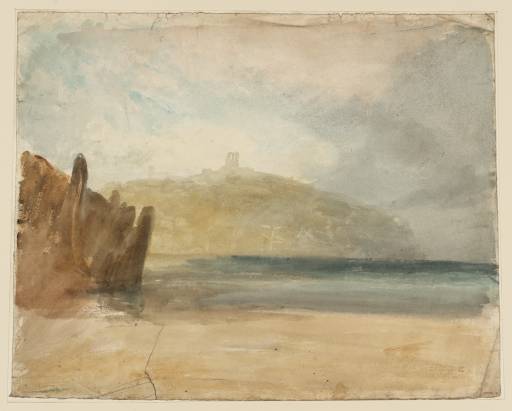Joseph Mallord William Turner Scarborough c.1809
Joseph Mallord William Turner,
Scarborough
c.1809
Joseph Mallord William Turner 1775–1851
Scarborough c.1809
D17166
Turner Bequest CXCVI B
Turner Bequest CXCVI B
Gouache and watercolour on white wove paper, 343 x 435 mm
Blind-stamped with Turner Bequest monogram towards bottom right
Stamped in black ‘CXCVI – B’ bottom right
Blind-stamped with Turner Bequest monogram towards bottom right
Stamped in black ‘CXCVI – B’ bottom right
Accepted by the nation as part of the Turner Bequest 1856
Exhibition history
1937
Sixty Pictures of Yorkshire Scenery, Leeds City Art Gallery, June–August 1937 (47, as ‘Scarborough’).
1947
?Scarborough Public Library, October 1947–January 1948 (as ‘CXVI B’, no catalogue).
References
1909
A.J. Finberg, A Complete Inventory of the Drawings of the Turner Bequest, London 1909, vol.I, p.599, CXCVI B, as ‘Scarborough. ... Probably study for the “Scarborough,” exhibited R.A. 1811, and now in possession of F.H. Fawkes, Esq., Farnley Hall’.
1937
Sixty Pictures of Yorkshire Scenery, exhibition catalogue, Leeds City Art Gallery 1937, p.12 no.47, as ‘Scarborough’.
1979
Andrew Wilton, J.M.W. Turner: His Life and Work, Fribourg 1979, p.360 under no.527.
1980
David Hill in Hill, Stanley Warburton, Mary Tussey and others, Turner in Yorkshire, exhibition catalogue, York City Art Gallery 1980, p.16 under no.10.
Finberg1 noted this as a likely study for the ambitious watercolour Scarborough Town and Castle: Morning, Boys Catching Crabs exhibited at the Royal Academy in 1811 (685 x 1015 mm; Art Gallery of South Australia, Adelaide),2 initially owned by Turner’s Yorkshire friend and patron Walter Fawkes (see the Introduction to the present section). Andrew Wilton has instead linked it convincingly to the relatively small Scarborough: Boys Crab Fishing of 1809 (279 x 398 mm; Wallace Collection, London),3 which had been painted for Fawkes’s relative, the amateur artist and collector Sir William Pilkington (1775–1850).4
The two finished works are fundamentally very similar in composition, with a steep bank shored up with wooden posts on the left acting as a repoussoir device for a prospect of Scarborough’s bay and castle beyond on the coast of North Yorkshire. The sky in the Wallace Collection work is clear and full of glowing morning light coming from the right, rather than the somewhat changeable clouds shown above the castle here. A much larger study (Tate D17167; Turner Bequest CXCVI C) is likely to relate directly to the 1811 work.
The basic composition is outlined in the 1801 Dunbar sketchbook (Tate D02770–D02771; Turner Bequest LIV 95a–96); David Hill has suggested that the large 1811 variant developed from the Pilkington picture, rather than from the original drawing’.5 Although Turner drew other aspects of the town and its setting in 1801 and around 1816, the watercolour Scarborough of 1818 (private collection)6 is a variant of the 1809 and 1811 compositions, albeit with more prominent cliffs on the left, while the Ports of England watercolour Scarborough, of about 1825 (Tate D18142; Turner Bequest CCVIII I)7 focuses in on the castle and its headland from a comparable angle.8
Manuscript exhibition records note the loan of Turner Bequest ‘CXVI B’ to Scarborough in 1947, although whether for the purpose of exhibition is unclear; that number relates to Tate D08103, the Liber Studiorum watercolour Woman with Tambourine, and perhaps the present works number, CXCVI B, was meant.
Technical notes:
Sails and masts have been washed out or reserved below the headland at the centre. The surface is soiled and creased, with tears and ingrained dirt particularly towards the bottom left. Presumably on account of its fragile condition, the sheet has been laid down on another of white wove paper, closely trimmed all round.
Verso:
Blank; laid down.
Matthew Imms
September 2016
How to cite
Matthew Imms, ‘Scarborough c.1809 by Joseph Mallord William Turner’, catalogue entry, September 2016, in David Blayney Brown (ed.), J.M.W. Turner: Sketchbooks, Drawings and Watercolours, Tate Research Publication, December 2016, https://www

